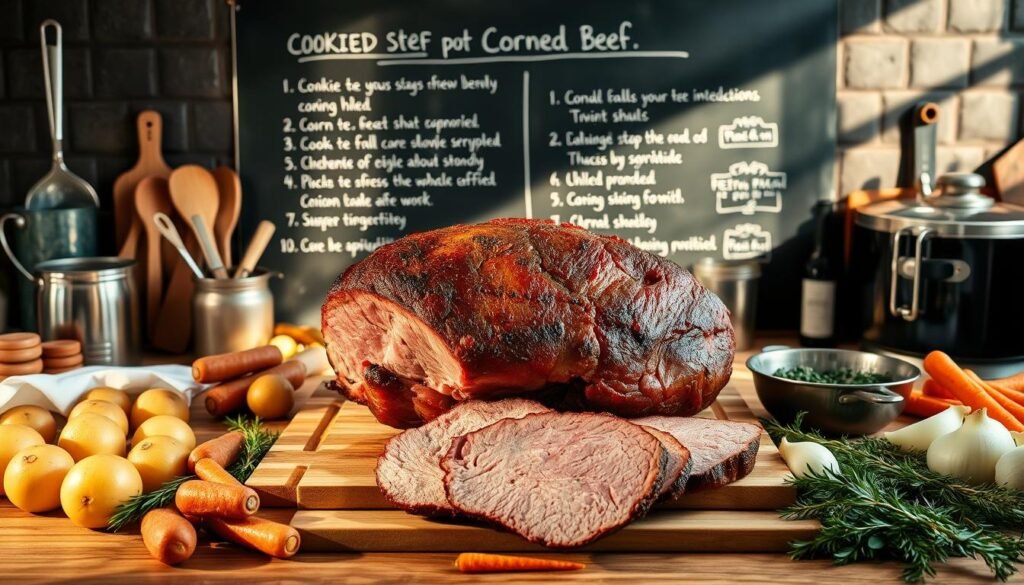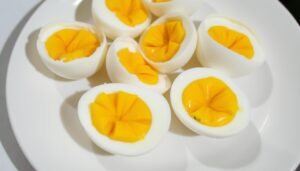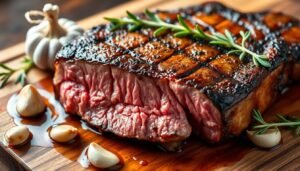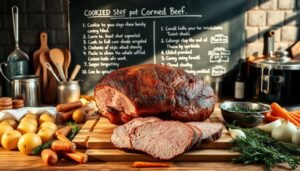Did you know that around 4 million corned beef dinners are served in the United States every year during St. Patrick’s Day alone? This dish is a favorite in American cuisine. If you want to learn how to cook corned beef, you’re in for a treat. With the right techniques and recipes, you can make a delicious meal that will wow your guests.
In this guide, I’ll show you everything you need to know about cooking corned beef. We’ll cover choosing the perfect cut and different cooking methods. I’ll share my top tips to make sure your dish is tender and tasty. So, let’s explore the world of corned beef and improve your cooking skills!
Key Takeaways
- Understand what corned beef is and its historical significance.
- Learn how to choose the right cut for your needs.
- Explore various cooking methods including boiling and slow cooking.
- Discover essential spices and vegetables for flavor enhancement.
- Get tips for perfect cooking times and temperatures.
- Know how to properly store leftover corned beef.
What is Corned Beef?
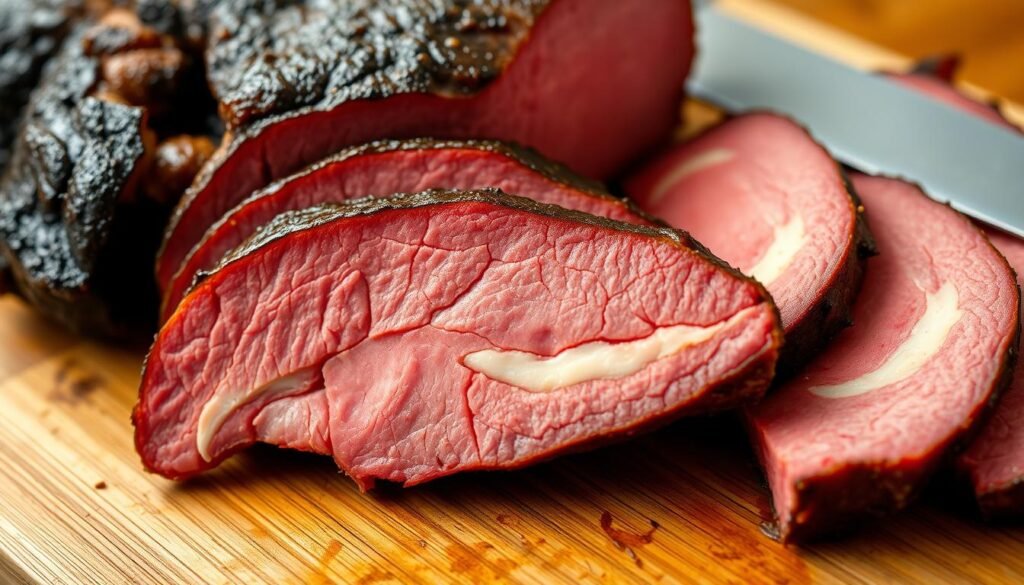
Corned beef is a dish many love, often enjoyed during holidays. It’s made from brisket, cured in a salty brine with pickling spices. The name “corned” comes from the coarse salt used, which adds its unique taste and texture.
This dish has a deep history, tied to many cultures and cooking traditions.
The History of Corned Beef
The history of corned beef starts in Ireland, where it was used to preserve meat. Irish immigrants brought it to the U.S., where it changed. In America, it became a sign of community and celebration, like on St. Patrick’s Day.
It went from a preservation method to a beloved dish in many homes.
Popular Uses in American Cuisine
Corned beef is a staple in American cuisine because of its flexibility. It’s great as a main dish with cabbage and potatoes or in sandwiches. Corned beef hash is also popular, perfect for breakfast or brunch.
Its salty, savory taste makes it a hit in many recipes, loved in American kitchens.
| Dish | Common Ingredients | Typical Serving Style |
|---|---|---|
| Corned Beef and Cabbage | Corned beef, cabbage, potatoes, carrots | Hot, as a main dish |
| Corned Beef Sandwich | Corned beef, rye bread, mustard | Cold or hot, in a sandwich |
| Corned Beef Hash | Corned beef, potatoes, onions, spices | Hot, often for breakfast |
Choosing the Right Cut of Corned Beef
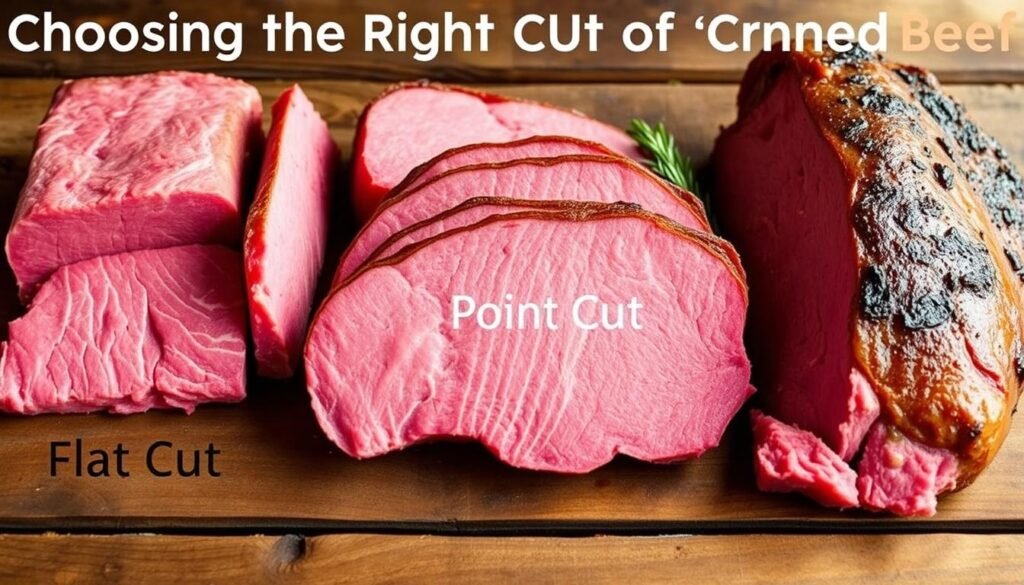
Choosing the right cut of corned beef is key to a great dish. The cut affects the flavor and tenderness. Knowing the differences helps you pick the best for your meal.
Lean vs. Fatty Cuts
Lean vs fatty corned beef is a matter of taste. Lean cuts, like flat cut brisket, are healthier with less fat. They’re great for those watching their diet.
Fatty cuts, like the point cut, have richer flavors and more moisture. This choice often sparks lively debates among cooks.
Different Types of Corned Beef
There are many types of corned beef to enhance your cooking. The most common cuts include:
| Type | Description | Fat Content |
|---|---|---|
| Flat Cut | Often leaner, known for its uniform shape and perfect for slicing. | Lower |
| Point Cut | Fattier than the flat cut, with a more intense flavor and moisture. | Higher |
| Round Cut | Less common, typically lean with a firmer texture; good for sandwiches. | Lower |
These options offer a variety of flavors and textures. It’s important to think about what you want when choosing corned beef. Whether you prefer healthier options or richer tastes, knowing about cuts will help you create a delicious dish.
Preparing Corned Beef for Cooking
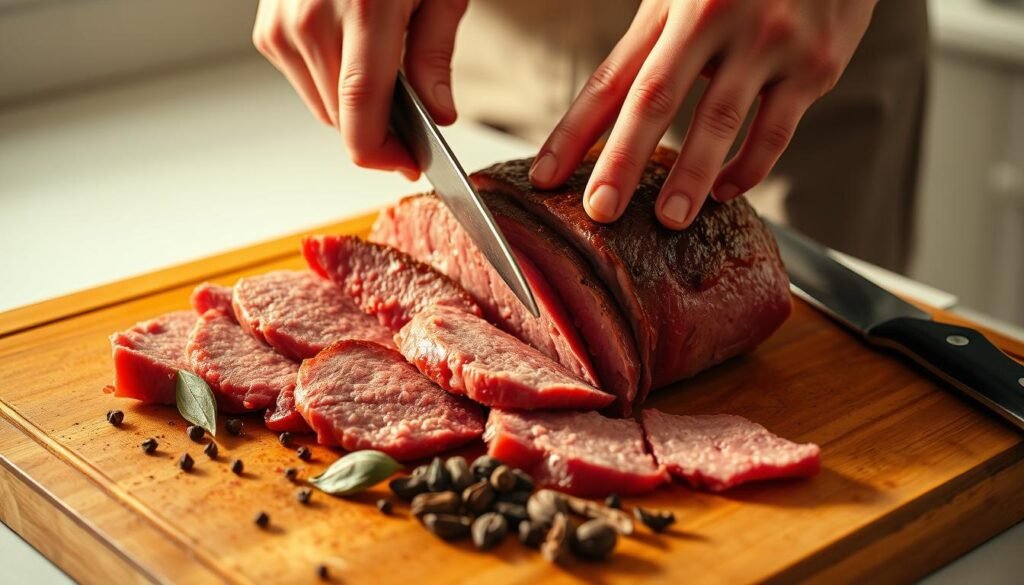
Before cooking, it’s key to prep the corned beef right. This means rinsing it to get rid of extra salt from brining. Rinsing makes the meat less salty and better at soaking up flavors.
After rinsing, drying the meat is important. It helps seasonings stick to it better.
Rinsing and Drying the Meat
I begin by rinsing the corned beef under cold water. This step removes the strong saltiness from brining. Then, I dry it with a paper towel.
Drying helps the meat take in flavors from marinades or spices better.
Marinating Tips for Extra Flavor
Marinating corned beef overnight can really boost its taste. I mix pickling spices, minced garlic, and apple cider vinegar for the marinade. This lets the flavors go deep into the meat.
Cooking Methods for Corned Beef
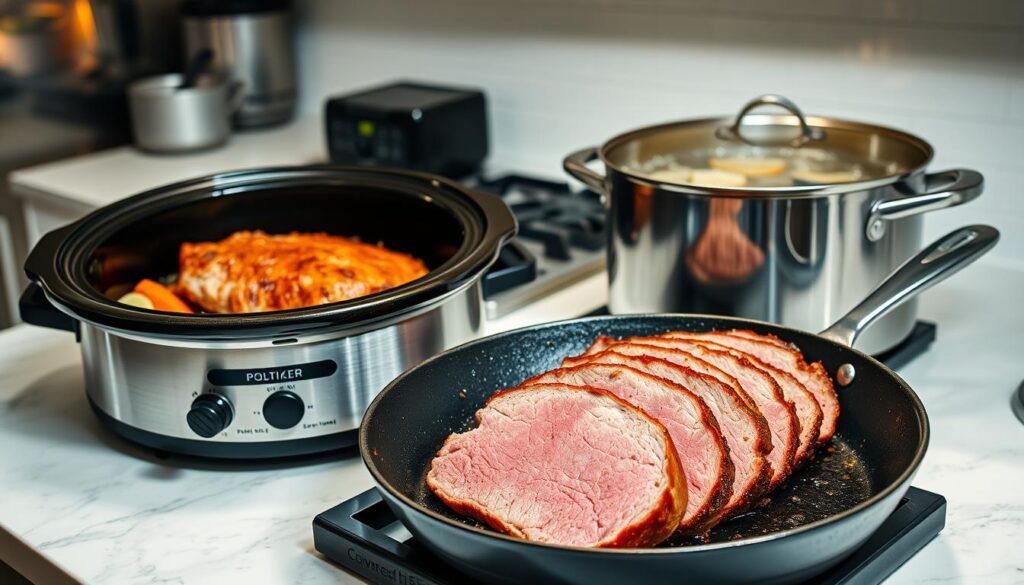
There are a few popular ways to cook corned beef that I really enjoy. Each method adds its own special flavor and texture. This lets me choose how I like my corned beef best.
Boiling Corned Beef
Boiling is a classic way to cook corned beef. I start by simmering it in a big pot of water with pickling spices. It takes a few hours, but the meat turns out tender and moist.
Slow Cooking for Tender Meat
For a low-maintenance option, I slow cook corned beef in a crockpot. This method lets all the flavors mix together slowly. The meat becomes incredibly tender, making it great for sandwiches or with sides.
Oven Roasting Corned Beef
Roasting corned beef in the oven gives it a unique texture and taste. I cook it at about 300°F to get a crispy outside and a juicy inside. Roasting offers a nice contrast to the tenderness of boiling or slow cooking.
| Cooking Method | Texture | Flavor | Time |
|---|---|---|---|
| Boil Corned Beef | Fork-tender | Moist with spice notes | Approximately 3-4 hours |
| Slow Cook Corned Beef | Very tender | Rich and savory | 6-8 hours on low |
| Roast Corned Beef | Crispy outside, juicy inside | Savory with caramelization | 3-4 hours |
Seasoning and Flavoring Your Corned Beef
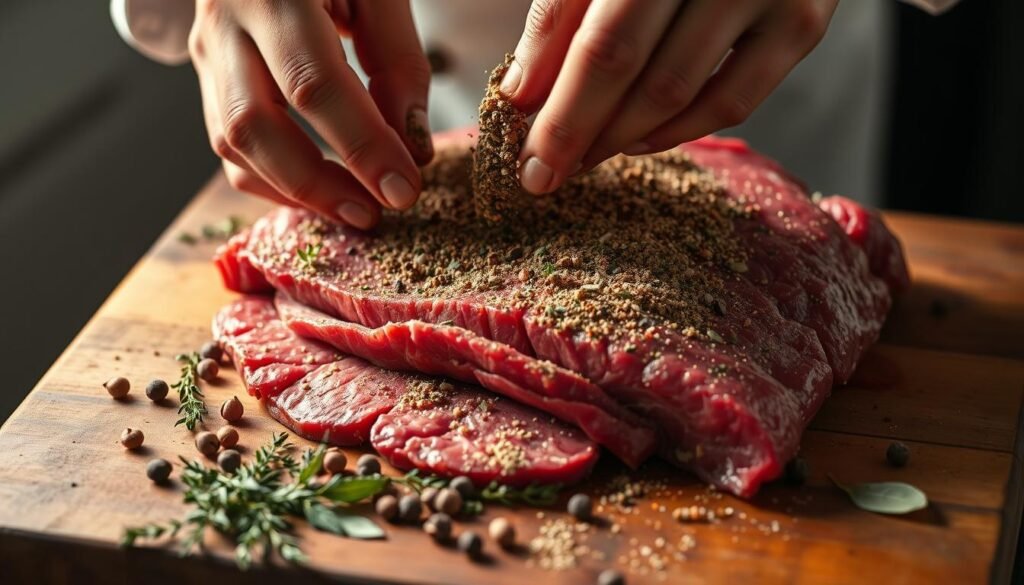
Seasoning corned beef with the right spices is key to making it special. The right spices can turn a simple dish into a feast. I love adding herbs and condiments to boost the flavor.
Essential Spices for Corned Beef
Choosing the right spices is crucial for great corned beef flavor. Here are some must-haves:
- Mustard seeds
- Peppercorns
- Coriander
- Allspice
- Bay leaves
These spices bring out the meat’s natural taste and add a savory smell to your kitchen. A bit of apple cider vinegar adds a tangy twist, balancing the dish’s richness.
Adding Vegetables for Extra Flavor
Adding fresh veggies can also make your corned beef better. Vegetable pairings for corned beef include:
- Carrots
- Potatoes
- Cabbage
These veggies add flavor and make the meal complete. Their sweetness contrasts with the savory meat, making each bite better. As they cook, they soak up the seasonings, creating a flavorful mix that goes well with the meat.
Cooking Times and Temperatures
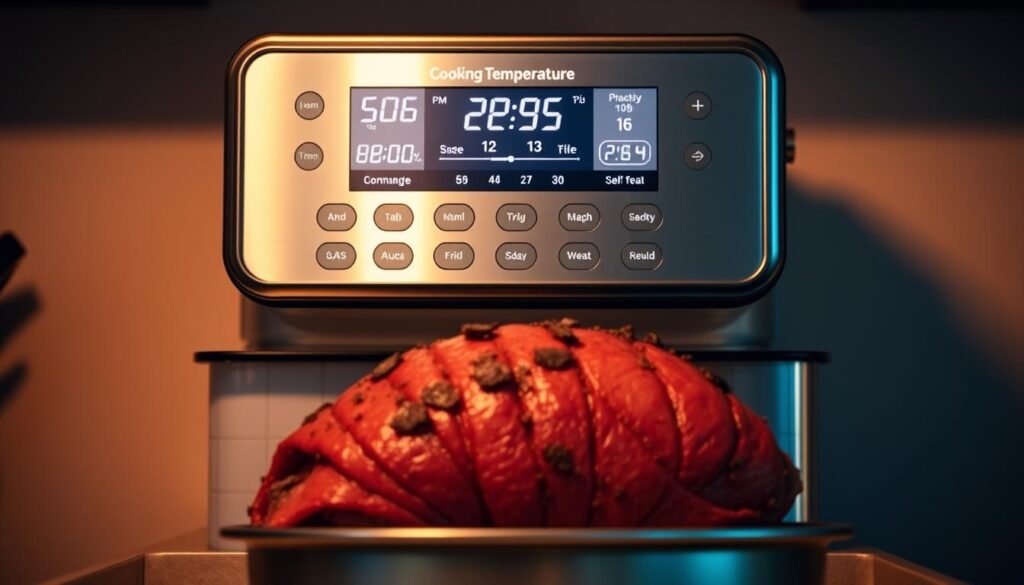
Perfectly cooked corned beef comes from knowing the right cooking temperatures and times. Each meat cut needs its own approach for tenderness and flavor. For instance, flat cut brisket usually takes 2.5 to 3 hours to boil. This knowledge makes dinner a success every time.
Understanding Cooking Times for Different Cuts
It’s key to know the meat’s weight when setting cooking times. Here’s a simple guide:
| Weight | Cooking Time |
|---|---|
| 1 lb | 1 hour |
| 2 lb | 2 hours |
| 2.25 lb | 2 hours 15 minutes |
| 2.5 lb | 2 hours 30 minutes |
| 2.75 lb | 2 hours 45 minutes |
| 3 lb | 3 hours |
| 3.5 lb | 3 hours 30 minutes |
If weights are uneven, round up to the nearest quarter pound. Always add extra time. Underestimating can ruin your dish.
Using a Meat Thermometer
A meat thermometer is crucial for the best results. It ensures the corned beef hits 190°F. This makes the meat tender. A good thermometer makes cooking easier and better. For more on cooking temperatures, see this link.
Serving Suggestions for Corned Beef
Serving corned beef can be both traditional and creative. I often go for classic pairings but also try new ways to enjoy it. Here are some tasty ideas to make your corned beef serving special.
Classic Pairings: Cabbage and Potatoes
Boiled cabbage and potatoes with corned beef is a favorite. It’s perfect for St. Patrick’s Day. I also like to add various side dishes to enhance the flavors. Mashed potatoes and colcannon are great choices that make the meal complete.
Creative Sandwich Ideas
For a modern take, try corned beef sandwiches. I layer it with Swiss cheese, sauerkraut, and creamy dressing on rye. Corned beef hash is another favorite, a tasty breakfast mix of potatoes and corned beef. This makes corned beef perfect for any meal.
| Serving Option | Description |
|---|---|
| Boiled Cabbage and Potatoes | A traditional Irish pairing, perfect for hearty meals. |
| Corned Beef Sandwiches | Classic deli-style sandwiches with Swiss cheese and sauerkraut. |
| Corned Beef Hash | A savory breakfast dish combining corned beef, potatoes, and seasonings. |
| Colcannon | Irish mashed potatoes with greens, complementing the corned beef beautifully. |
Exploring corned beef’s versatility makes cooking more fun. It brings people together, reminding us of good times and loved ones. Every bite of corned beef is a celebration of togetherness.
Storing Leftover Corned Beef
After enjoying a delicious meal with corned beef, it’s important to know how to store leftovers. I want to keep the meat’s flavor and quality. The way we store corned beef affects how long it stays fresh.
Proper Refrigeration Techniques
First, refrigerate corned beef within two hours after cooking or reheating. This stops bacteria from growing. I use an airtight container to keep it fresh for up to four days. Make sure the container is sealed well to keep odors out.
Freezing Corned Beef for Future Meals
To save corned beef for longer, freezing is best. It can be frozen for two to three months without losing flavor or texture. I wrap it tightly in freezer-safe bags, removing as much air as I can before sealing.
When I thaw frozen corned beef, I do it in the fridge overnight. This way, I keep the meat moist and tender. Following these steps helps me store corned beef effectively, keeping it good for days or weeks.
| Storage Method | Time | Best Practices |
|---|---|---|
| Refrigerating Corned Beef | 3-4 days | Airtight container, refrigerate within 2 hours |
| Freezing Corned Beef | 2-3 months | Tightly wrapped in freezer-safe bags |
For more tips on preparing and storing corned beef, check out this helpful guide on preserving corned beef.
Tips for Perfectly Cooked Corned Beef
Cooking corned beef can be a fun experience. But, there are key things to keep in mind for the best results. By avoiding common mistakes, I can make sure my corned beef is tender and not too salty.
Common Mistakes to Avoid
One big mistake is overcooking the meat. This makes it dry and tough. I prefer a gentle simmer instead of a rolling boil for even cooking.
Choosing the right cut of meat is also important. A brisket with fat adds flavor. And, letting the meat rest for 15 minutes after cooking is crucial. This helps the juices spread, making the meat more flavorful and moist.You can learn more abour how to cook a ham.
Tricks for Achieving Tenderness
To make corned beef tender, I cut it against the grain. This breaks down the fibers, making it softer. Sometimes, I marinate the meat in a brine for extra flavor and tenderness.
Following brining and cooking times is key. A pressure cooker can cook corned beef in 65 to 75 minutes. Without one, a Dutch oven works well for a slow roast, taking 2 to 3 hours.
For more tips, check out this resource on cooking tips for corned beef. These tips will help me improve my corned beef cooking.
Fun Facts About Corned Beef
Corned beef is more than just a tasty meal; it’s a big part of American culture, big on St. Patrick’s Day. This holiday is all about corned beef, showing its importance in Irish-American culture. I enjoy celebrating by eating tender corned beef with traditional sides. It’s a great way to bring friends and family together.
Cultural Significance in American Holidays
Exploring the cultural significance of corned beef shows its journey from Ireland. Irish food once had bacon with cabbage, but money issues led to corned beef in America. This dish has become a symbol of celebration and unity, thanks to immigrants.
Surprising Nutritional Facts
Looking at the nutritional value of corned beef, it’s good and bad. It’s packed with protein and nutrients, great for a healthy diet. But, it’s also high in sodium and fat, so eat it in moderation. Knowing these facts helps me enjoy corned beef wisely, balancing taste with health.


